
You are reading the older HTML site
Positive Feedback
ISSUE
25
may/june
ecosse cables
Symphony interconnects, Big Red AC cords, and the SMS2.4 speaker cables
as reviewed by John Acton
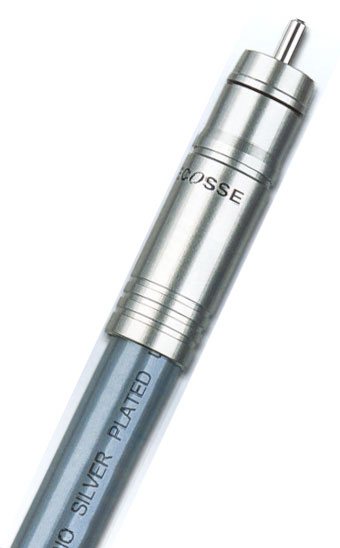
|
JOHN ACTON'S SYSTEM
LOUDSPEAKERS
ELECTRONICS
SOURCES
CABLES
ACCESSORIES
|
The recent proliferation of cable companies has been staggering. I suspect that cables represent the fastest-growing segment of high-end audio, but with so many products to choose from, I find myself reassured by companies that have a proven track record. Ecosse Reference Cables of Scotland is one such company. While not well known in the US, Ecosse is a household name in Europe, and distributes its products worldwide.
Eliot Davis, the founder of Ecosse, got his start in the music industry as a concert promoter. From there, he went on to manage and record artists in his own Glasgow recording studios. Looking to maximize the performance of his studios, Davis discovered that cables were the weakest link. Refusing to compromise, he started his own company. The rest, as they say, is history. Ecosse is now one of the few cable companies that has its own laboratory and factory, allowing for complete freedom in producing no-compromise products. The winner of many awards in the British press, Ecosse offers cable solutions for every application, from entry-level systems all the way to cost-no-object rigs, and prides itself on offering superior performance at every price point. Much more information regarding Ecosse and its products can be found at www.ecossecables.co.uk, one of the most informative company websites I've seen.
The folks at Ecosse are major proponents of system and cable synergy, and based upon the system details I provided, they recommended interconnects, speaker cables, and power cords for me to review. The AC cables were the Big Red SC Power Chords ($285 per meter), the speaker cables were the single-wire SMS2.4s ($1100 per 3-meter pair), and the interconnects were their newest model, the Symphony ($325 per .8-meter pair). The cables arrived well packaged, with a certificate of authenticity signed by the assembler and tester.
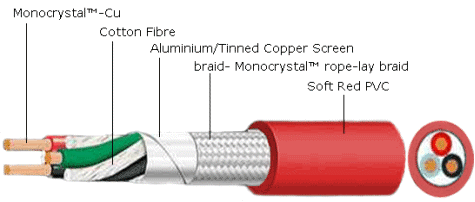
First up were the Big Red SC Power Chords. Compared to the unwieldy Virtual Dynamics and Custom Power Cord cables I have been using, the svelte and flexible Ecosse cords were a breath of fresh air. No more needing to position my rack several feet from the wall and having to wrestle the power cords into position—I was able to easily coil the Big Red cords behind my rack to ensure that they didn't get too close to the interconnects and speaker cables. Despite the name, the Big Red cord is not that big. It is, however, extremely red. In spite of its comparatively diminutive diameter, the Big Red is designed to handle 7.5 kVa of current while rising a mere two degrees centigrade in temperature. It utilizes Ecosse's monocrystal technology, whereby a patented casting process creates an ultra-pure single-crystal copper conductor with fewer impurities and oxygen/hydrogen grain boundaries than conventional conductors. The result is a cable with better conductivity and purity, as well as greater flexibility and strength.
There are three versions of the Big Red, with increasing levels of performance as you move up the line. The cable remains the same in all three models, the difference being the quality of the connectors. Starting at the bottom, the Big Red HC employs a Schurter IEC connector, the Big Red SC has a monocrystal copper contact-pin IEC, and the flagship UC uses a no-holds-barred Furutech gold-plated, anti-magnetic IEC. Ecosse says that they require anywhere from 72 to 300 hours of break-in depending upon the model, and I adhered to these guidelines. I connected the Big Reds to a couple of PCs for several weeks prior to installing them in my system. Once installed, I heard no sonic changes over the course of the review.
How did they sound? In a word, amazing. Inserting them into my system excised a layer of grunge, grit, and haze from the sonic picture. I heard greater dynamic contrast, a larger and more cohesive soundstage, and a clearer, more realistic rendering of tonality. On "Step Into My Office, Baby" from Belle and Sebastian's Dear Catastrophe Waitress (Rough Trade 06076-83216-2), the pounding drums were portrayed with more dynamic realism than before, and the voices were more dimensional, present, and palpable. The soundstage was deeper and wider, and more removed from the physical boundaries of the speakers. I felt that I was hearing more of the performance and less of the system. At less than half the price of my reference power cords, the Ecosse Big Red SC cords blew me away.
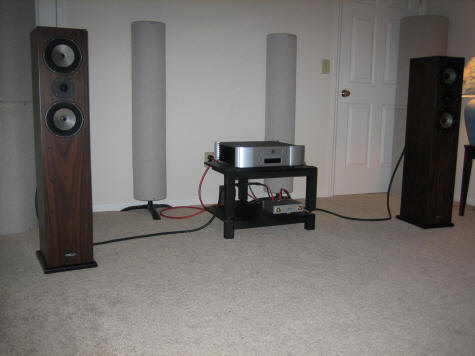
With the Big Reds in the system, the bass was tighter, with less bloat and overhang, but never sounded lean or anemic. I was able to hear more detail in the bass effects that are key to the success of Boards of Canada's newest release, The Campfire Headphase (Warp 123). The superior soundstaging of the Ecosse power cords allowed me to hear deeper into the mix, and to lose myself in the surreal soundscape. This preternatural clarity was also maintained further up the frequency spectrum. The midrange was open and expressive, and the treble clean and incisive, without a hint of grain or hash. I was thrilled with the natural manner in which Adam Nussbaum's cymbal work was rendered on "Rain Forest," from John Abercrombie's CD While We're Young (ECM 1489 314 517 352-2). The Custom Power Cord HCF II and HCF II Special power cords have been my references for some time, and they are truly excellent, but they were clearly bettered by the Ecosse Big Red SCs. They sounded slow, bloated, and grainy in comparison. The Ecosse cables were cleaner and quicker, with greater expressiveness, cohesiveness, and accuracy.
I don't like rave reviews, as I hate to have no place to go when the next "best thing" comes along. In this instance, though, I can truly say that I couldn't hear anything wrong with the Ecosse Big Reds. Some listeners might find them to be a touch on the bright side, but as they showed no grain or other anomalies, I have concluded that they are simply honest to the source. For the price, I give the Ecosse Big Red SC Power Chords my highest recommendation.
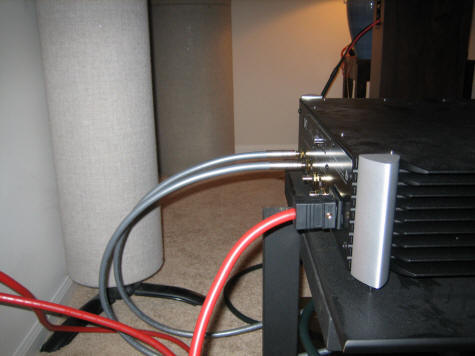
After the soul-stirring performance of the Big Reds, I was eager to move on to the Symphony interconnects. The Symphonies are formidable-looking cables that are nearly as large in diameter as the Big Reds. The Symphony cables are attractive in their silver jackets and matching silver RCA connectors, but their beauty is more than skin deep, as the proprietary connectors are silver-plated copper and the copper shields and center pin are configured to form a Faraday Cage for reducing RFI. Internally, the Symphony eschews monocrystal conductors for ultra-high-purity oxygen-free-copper conductors, but they are silver-plated for greater conductivity, and the silver is also of ultra-high purity. The Isohelix layout of the conductors and the triple layers of shielding are designed to eradicate RFI and EMI interference, as is the gas-foamed low-density polyethylene dielectric.
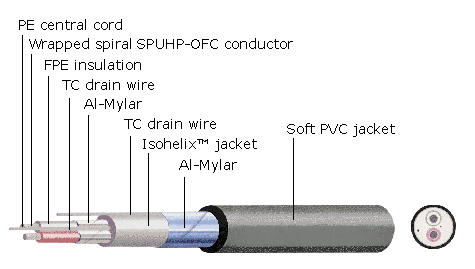
While not quite as flexible as the Big Red SC power cords, the Symphony interconnects were still very easy to handle. Their directionality is supposed to be denoted via arrows on the jacket sleeves, but I could not find the arrows, and installed the cables in the direction of the writing on the jackets. I broke in the cables for several hundred hours in a second system prior to installing them in my main rig.
The sound of the Symphony interconnects was very much in line with that of the Big Red power cords. Ecosse's effort to minimize all forms of interference appears to have paid off, as the cables were incredibly quiet. Backgrounds were blacker, and I was able to hear further back into the soundstage and discern the minutest of details with ease. When I played "Joanni," from Kate Bush's long-awaited Aerial release (Columbia 82796 97772 2), I was able to clearly discern the subtle interplay of background voices and instruments underpinning Bush's vocals. Another result of the Symphonies' exemplary level of quietude was their tremendous jump-factor. Dynamic contrasts were very realistic. The organ and horns on "My Rival," on Steely Dan's Gaucho (MCA 088 112 055-2) blasted onto the scene, juxtaposing Donald Fagen's understated vocal with truculent urgency.
The Symphony interconnects were impressively quick, grabbing hold and letting go of notes with remarkable celerity. Notes were clear and distinct, never blurring or running into each other no matter how complex or muddled the recording. Perhaps owing to their speed, ease, and clarity, the Symphony interconnects threw a large soundstage containing well-delineated images. Though honest and uncolored, the Symphonies deviated from neutrality just the slightest bit in favor of the uppermost registers. On Beth Orton's newest CD, Comfort of Strangers (Astralwerks ASW 49847), I occasionally discerned a hint of stridency in vocal sibilants on songs like "Conceived" and "Safe in Your Arms." I am really picking nits here, as this emphasis was slight enough to be insignificant. The midrange was exceedingly neutral, sounding neither warm nor lean—which is ideal, as it lets the recording speak for itself. The bass was likewise extended and tight, without any thickening or warmth to detract from the performance.
Compared to my reference Audience Au24 interconnects, the Symphony cables were bigger sounding, with a larger soundstage and a more dynamic presentation. The Symphonies were a little more upfront, with a slightly brighter treble register. The midbass was just a little more lean, which was a benefit or liability depending upon the recording. The Au24s sounded more laid-back and relaxed. They excelled in the continuity of their presentation, and groups of instruments spoke with a more coherent voice than they did with the Symphonies. The midbass had just a hint of bloom, and the treble, while clean and extended, was not quite as forward as that of the Symphony cables. While both interconnects were excellent, and the two are clearly competitive, they will appeal to different tastes, and you will need to hear them in the context of your own system before you commit to purchasing either.
While not quite the giant-killers that the Big Red SC power cords turned out to be, the Symphony interconnects impressed me with their outstanding dynamics, exemplary reproduction of detail, and enveloping soundstage. Essentially neutral, the Symphonies are lively sounding cables, and their big, bold sound makes every listening session an event. At the price, the Symphony interconnects are something of a bargain, and an easy recommendation.
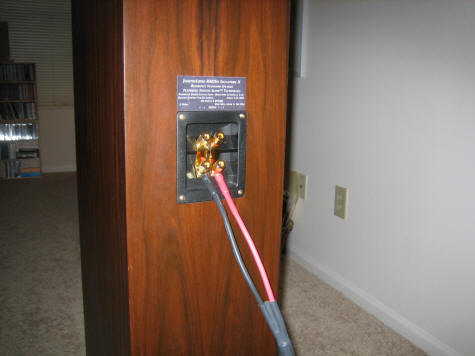
Last up were the SMS2.4 loudspeaker cables. These pride-and-joy products for Ecosse make use of a revolutionary copper conductor technology dubbed "super-monocrystal." Super-monocrystal conductors are even more pure than their monocrystal siblings, with a 7N rating vs. the 5N rating of standard monocrystal. In the SMS2.4s, the quality of the conductors is enhanced by their differing cross-sectional size and braided construction, which provides greater phase coherence and linearity. Polyethylene dielectric and PVC outer jackets are employed to reduce EMI and RFI interference. The terminations are monocrystal spade lugs. Like the Big Red power cords, the SMS2.4 speaker cables are ultra-flexible, making installation a snap. The SMS2.4 s are almost as thick as the Big Red cords, and are darkish-green in color. Among the attributes of monocrystal and super-monocrystal cables is a lack of directionality, but as I did with the Symphony interconnects, I installed the SMS2.4s in the direction of the writing on the jacket. The break-in time was lengthy. The SMS2.4s sounded slightly grainy and shut-in until they had accumulated more than 200 hours of playing time.
Once broken in, the SMS2.4s' sound was enlightening. With very little coloration, the SMS2.4s simply got out of the way. With them in the system, it was easier to discern differences between recordings and upstream components. This made it difficult to ascribe any sonic characteristics to the speaker cables. Just when I thought I had their sound nailed, a new recording or component would send me back to the drawing board. The soundstage was large, and detached from the speakers, but would swell and constrict depending upon the recording and/or upstream components.
The SMS2.4s' portrayal of dynamics was superb, but—again—extremely honest. Their dynamic veracity made me aware of the differences between superb recordings like "Ron Carter" from Bill Frisell's CD Blues Dream (Nonesuch 79615-2) and dynamically starved cuts like "Who Killed Tangerine" from Tears for Fears' Everyone Loves a Happy Ending (New Door Records B0003042-02). Maddeningly neutral from a reviewer's standpoint, the SMS2.4s provided an undiluted conduit for the tonal vagaries of recordings and associated equipment.
When I compared the Ecosse SMS 2.4 loudspeaker cables to the Audience Au24s, the two cables sounded more alike than not, not surprising since both are voiced for neutrality. The Au24s were slightly richer in the midbass, while the SMS2.4s were neutral across the spectrum, with a soundstage that was slightly larger and more detached from the speakers. The Ecosse SMS2.4s get very close to the Platonic ideal of neutrality. If they have a shortcoming, it is the very neutrality that is also their greatest asset. The SMS2.4s editorialize so little that some listeners will find them uninvolving, not realizing that it is another component that is to blame (not to mention their own sonic proclivities and prejudices). Listeners seeking hyped treble, exaggerated warmth, dynamic hyperbole, etc., should look elsewhere. Those who want the truth, the whole truth, and nothing but the truth will find it in the Ecosse SMS2.4s.
Having lived with the Ecosse cables for the last three months, my enthusiasm for them has increased the more I use them. They offer state-of-the-art performance, yet remain competitively priced, to the point of being out-and-out bargains. While not widely available in this country, Ecosse's cable products are worth the effort to find—they're that good. John Acton
Ecosse Cables
web address:
www.ecossecables.co.uk
